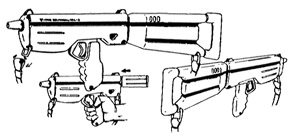

Designation:RRG - Tiresia
|

|
||||

|
|||||
 |
| A Resistance fighter on Invid-occupied Earth fires his FAL-2. |
The FAL-2, like the SAL-9, was created in response to the need for the REF to develop laser weapons for its infantry. As with the SAL-9, one of the goals of the FAL project was to be able to penetrate charged-particle force fields that could stop an Owens blast; another goal was to fire a much more powerful energy blast, on par with the Robotech Masters' T'luaza, paving the way toward phasing out the Wolverine and its bulky ammunition, and reducing reliance on the RL-2 and RL-6 rocket launchers in the man-portable anti-mecha role. However, in developing the FAL-2, the Robotech Research Group ran up against a problem of capacity: the capacitor magazines they were capable of developing at that time were not able to hold a sufficient amount of power for more than a half-dozen shots at the desired power levels.
Fortunately, a solution was found. The REF had become increasingly adept at working with protoculture power cells, replacing the self-contained protoculture engines from first-generation Valkyries with miniaturized expendable protoculture cell systems for their new Veritech mecha. From there it was a simple matter to devise an even smaller protoculture fuel cell that would fit into an attachable rifle stock. Although this sacrificed the field-expedient recharge ability of the Owens and SAL-9, it meant the rifle could fire blasts that were ten times as powerful as the Owens's anti-armor shot, making it a potent anti-personnel and even anti-mecha weapon. (1)
Another noteworthy innovation was the use of a SAL-9 magazine connector to attach the rifle stock. Since the FAL-2 used a refinement of the same firing mechanism as the SAL-9, this meant a SAL-9 magazine could be attached instead of the rifle stock to enable the FAL-2 to emulate a SAL-9. As the FAL-2's size and weight without the stock were similar to the SAL-9's but with much better ergonomics, this also had the effect of rendering the SAL-9 all but obsolete. As with the SAL-9, the FAL-2 offers a substantially greater pinpoint accuracy than the wider-beam Owens and Gallant weapons; it is not unusual to see a FAL-2 equipped with a sniper scope for making longer range shots.
Early field tests showed that the FAL-2 was a capable infantry weapon, and a much more powerful beam weapon than the Owens gun. However, the custom protoculture cell was expensive to produce, and the lack of a field-expedient recharge procedure meant it would require additional logistical considerations in the field. Though the FAL-2 was seen side-by-side with the Wolverine in the field, the expense and logistical issues caused it never to be adopted by the REF in large numbers. Even with these drawbacks, it is still possible the FAL-2 could have been more widely produced and issued if its special anti-force-field properties had been needed; however, the REF never encountered any adversaries who used the type of force fields that would have made it necessary, and the Gallant H-90 proved to be a much more economical solution. A few FAL-2 carbines are still in limited use today, by special forces units who need the enhanced accuracy of a laser weapon.
Although it was never manufactured on Earth, a number of FAL-2 carbines found their way into the hands of the anti-Invid Resistance from soldiers who returned with the Pioneer mission to fight the Robotech Masters, and from salvage from wrecked troop carriers of the 10th and 21st Mars Division deployments. Due to the rarity, non-rechargeability, and detectability by Invid of protoculture cell attachments, any FAL-2s wielded by the Resistance are usually powered by SAL-9 magazines. The ruggedness, accuracy, rechargeability, and non-protoculture nature of the gun in SAL-9 mode made it a valued weapon to the freedom fighter who found it. Many of these weapons are still in civilian hands.
The FAL-2's use of a specialized protoculture cell and interchangeable magazine types are considered to be in large part an inspiration for the later Gallant rifle.
(1) Unlike the later Gallant H-90 rifle's cell, the FAL-2 protoculture cell does not have an easy field-expedient recharge procedure; however, resourceful bio-maintenance engineers have been able to jury rig it.
Go to REF Armor/Weapons Index.
Go to the Robotech Reference Guide Home Page.
Robotech (R) is the property of Harmony Gold. This document is in no way intended to infringe upon their rights.
Content by Peter Walker and Pieter Thomassen, with Chris Meadows and Rob Morgenstern